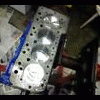
Getting My Head Around Heads...
#1

Posted 16 October 2008 - 10:38 PM
I know what a cylinder head is. In fact I recently took mine off to replace the gasket.
I cleaned it and gave it a good once over according to what it said in the manual. Then
I fitted the new gasket and put it back on. Here endeth my knowledge of heads.
But I see SO many posts about this type of head and that type - I see loads for sale on eBay
and on this forum - I'd like to know more to find out what I could do to mine, or which I might
like to replace it with, and why I would... If I did replace it what else would be wise to do...
It's clearly a big topic, would some guru like to write an essay for all of us lesser mortals to
understand at least the basics ?
Best wishes
Monty
PS - in return I'm happy to write "how to take decent pictures of your car (or anything) with a standard digital camera"
#2

Posted 16 October 2008 - 11:11 PM
If you've got a 1275 then a 12G 940 casting is really the only option, it was used on all engines from the beginning of the 70's. Later one's can be identified by the raised profile of the gasket faces for the thermostat etc. Improving the valve seats and guides for flow will have the greatest effect but you'd be best off doing some reading to get clued up.
#3

Posted 16 October 2008 - 11:26 PM
Buy a copy - There only about £15 posted on amazon
#4

Posted 16 October 2008 - 11:36 PM
On the underside of the cylinder head are combustion chambers for each cylinder which is the space the incoming mixture is compressed into, (by the rising piston) before being ignited by the spark plug (also located in the chamber).
On the top of the head are the valve springs, the valve stems and rockers. The springs are responsible for keeping the valves closed when 'off cam' (so that compression can be achieved, for example). The rockers simply transfer the movement of the cam down below in the body of the engine to the valves - they are a pivot point. Valve stems are the long thin neck of valves which run in pressed in tubes in the cylinder head called valve guides.
On the back of an A series head are the entrances to both the inlet and exhaust ports. Most engines will have 2 ports for each cylinder - 1 exhaust, 1 inlet, so 8 in total. Ours only have 5 in total: There are only 2 inlet ports and these are shared ports, meaning at the end of the port there are two valves leading to two adjacent cylinders. There are 3 exhaust ports. The cylinders at each end have a port each, but the inner two cylinders share an exhaust port.
On the front of the head are the spark plug threads.
The head isn't solid and is cast with water galleries to aid cooling. It also has a hole to transmit oil up to the rockers to lubricate the valve guides, rocker bushes and rocker pads.
More intrinsic detail exists with heads - especially concerning modification. I recommend David Vizard's 'Tuning the A series engine' for this. Looking at a head in standard form, it isn't designed to flow a lot of air, but is mass produced to be reliable and to give good economy. Modifications include grinding out exhaust and inlet ports to remove restrictions to the passage of gas. This is complex as you can break into the aforementioned water galleries. It is also a case where bigger is not always better, where shape and finish also have a big effect on the performance of the head.
Where the head of the valve rests on the underside of the head is called the valve seat, and this can also be subject to modification as well as the fitment of hardened seats for the usage of unleaded fuel (mainly on exhausts, these are held in by heating the head and putting the inserts themselves in a coolant so that a solid fit at consistent temperatures is achieved.
Looking at what head is good for your engine - well a 998 traditionally would perform well with a 12G295 cylinder head, but the head needs a good skim first. This is because the head had less restrictive ports from standard, and also had larger valves. You can fit alternative heads such as the 12G202. a CAM4810 is most common on 998s and is quite restrictive as well as the combustion chamber being quite "shrouded" which isn't the best for airflow. These can be modified as per Vizard's book to release some potential.
Large bore engines mostly use the 12G940 head. This will fit on a 998 but you will need to pocket the block as the valves will hit the corner of the block. This is a careful machining procedure not to be taken lightly. The 12G940 head is available in 33/29 mm exhaust sizes as well as larger 35/29mm MG metro sixes, with most modified heads having the larger inlet valve fitted. The combustion chamber is a less restrictive shape than small bore engines although it can still be modified by grinding out the ports.
I think that's all I can spiel off the top of my head. There are extensive topics concerning most cylinder head equipment, such as materials of valve guides and spring selection, rocker ratio, valve seat choice, valve choice, combustion chamber size (for calculating compression ratio) much of which you will find in Calver's Corner on the minispares website. 'Tis some good reading.
Anyway hope this is easy to digest.
Tom
#5

Posted 16 October 2008 - 11:47 PM
Has lots of interesting pictures - Helps to demonstrate what modifications are done during the stages of head work.
Also regarding the stages of tune for heads:
Stage 1 - Simple gas flowing, ports, skimmed
Stage 2 - Chamber modifications, serious porting
Stage 3 - Big inlet OR big exhuast valves
Stage 4 - Big inlet AND big exhaust valves
Stage 5 - All the above plus special things like angled guides, etc.
Thats was taken from the FAQ that jammy wrote.
Don't confuse this with the tuning kits availible for A series engines - For example a 998 stage 1 doesn't usually mean its had any head work done. Those terms are purely regarding cylinder heads.
#6

Posted 17 October 2008 - 12:01 AM
Ask a newb question and within minutes you have a ton of info and a whole host of leads to follow.
Tom - I hope you are actually a teacher, if not you could make a good living as a preacher of science
to the masses. (The BBC pays good money for people like you...)
Some reading to do for me and a book to buy.
Thanks all.
Best wishes
Monty
#7

Posted 17 October 2008 - 12:02 AM
This is also a good read: http://miniclassic.y...dify-heads.html
Has lots of interesting pictures - Helps to demonstrate what modifications are done during the stages of head work.
Also regarding the stages of tune for heads:
Stage 1 - Simple gas flowing, ports, skimmed
Stage 2 - Chamber modifications, serious porting
Stage 3 - Big inlet OR big exhuast valves
Stage 4 - Big inlet AND big exhaust valves
Stage 5 - All the above plus special things like angled guides, etc.
Thats was taken from the FAQ that jammy wrote.
Don't confuse this with the tuning kits availible for A series engines - For example a 998 stage 1 doesn't usually mean its had any head work done. Those terms are purely regarding cylinder heads.
WOw, didn't realise this was still around - I took those photos!
#8

Posted 17 October 2008 - 12:08 AM
#9
 Guest_iansmini_*
Guest_iansmini_*
Posted 17 October 2008 - 12:13 AM
I love that link as good as if not better than reading the modifying heads chapter in Vizards' book.
1 user(s) are reading this topic
0 members, 1 guests, 0 anonymous users















